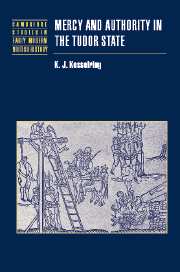Book contents
- Frontmatter
- Contents
- Acknowledgments
- Abbreviations and conventions
- 1 Introduction: mercy and the state
- 2 Changing approaches to punishment and mitigation
- 3 Changing approaches to the pardon
- 4 Patronage, petitions, and the motives for mercy
- 5 Public performances of pardon
- 6 Protest and pardons
- 7 Conclusion
- Appendix I Sources
- Appendix II Benefit of the belly
- Bibliography
- Index
- Titles in the series
Appendix II - Benefit of the belly
Published online by Cambridge University Press: 05 July 2009
- Frontmatter
- Contents
- Acknowledgments
- Abbreviations and conventions
- 1 Introduction: mercy and the state
- 2 Changing approaches to punishment and mitigation
- 3 Changing approaches to the pardon
- 4 Patronage, petitions, and the motives for mercy
- 5 Public performances of pardon
- 6 Protest and pardons
- 7 Conclusion
- Appendix I Sources
- Appendix II Benefit of the belly
- Bibliography
- Index
- Titles in the series
Summary
Benefit of clergy and benefit of the belly are often assumed to be largely analogous practices; they were gender specific, but both saved convicts from the gallows. Benefit of clergy did not serve to protect female convicts in the Tudor period. Judges and members of parliament had willingly extended the fiction of clerical status to almost any man, but not to women. In 1624, parliament allowed women to claim the privilege, but only for theft of goods worth 10s or less. From then until the full extension of the benefit of clergy to women in 1693, their inability to claim this privilege on the same terms as men demonstrated an even more obvious bias on the part of lawmakers. Until 1693, women had to rely on their ability to bear children rather than their ability to read in order to stall an execution. In Elizabeth's reign, just under 25 percent of the women convicted at the Essex assizes successfully postponed their executions through a plea of pregnancy. In the other counties of the Home Circuit, somewhat higher percentages prevailed, with Surrey having the highest proportion of female convicts – just over 60 percent – earning a respite from death. In all, 224, or 41 percent, of the women convicted on the Home Circuit successfully pleaded pregnancy. This would seem to compare quite favorably with the 48.6 percent of male convicts who obtained benefit of clergy.
Benefit of clergy and benefit of the belly were not, however, analogous practices.
- Type
- Chapter
- Information
- Mercy and Authority in the Tudor State , pp. 212 - 214Publisher: Cambridge University PressPrint publication year: 2003



